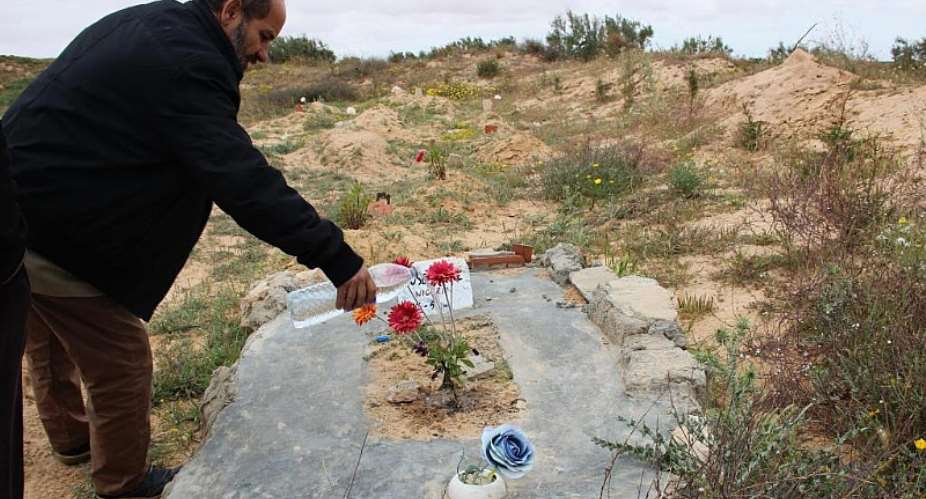For the past eight years, Chamseddine Marzoug, a former fisherman from the Tunisian town of Zarzis, has been burying the bodies of men, women and children drowned in the Mediterranean while attempting to reach Europe.
A former landfill outside the town of Zarzis, on Tunisia's southern coast, has provided space for giving a proper burial to the drowned migrants since the 2011 revolution.
Marked by a sign displayed in six languages, the Cemetery for the Unknown has more than 400 graves today. It has grown so full that many bodies are buried one on top of another.
A former fisherman named Chamseddine Marzoug is the one who came up with the initiative, touched by the sight of corpses starting to wash up on the shores of Zarzis back in 2004.
Walking across the makeshift cemetery for migrants, he explains why he took up the task of digging graves.
“Everybody is turning their back on these miserable people. The idea is to give then some humanity,” he explains.
Marzoug takes dead bodies from the sea, carries them to hospital for a medical report, washes and buries them. He goes to the cemetery at least three times a week for routine maintenance. He carries out his honourable mission, motivated by outrage at the fate of the mostly African migrants who die at sea when trying to cross the Mediterranean to seek a better life.
“For me, each of these graves is the same. Every grave means a wish, a dream, it's humanity for me.”
The small piece of land is crowded with unmarked graves, flowers and toys placed on top of them. The bodies of these dead migrants are neither registered nor documented, which makes it impossible to establish their identity, age or nationality.
Only one grave can be seen carrying the name of “Rosemary”, a young Nigerian woman who died at sea on 27 May 2017 after struggling to fight malaria she caught six months before in Libya.
Her boyfriend, Amadine Nousa, remembered that day when the boat carrying him and his beloved with another 100 migrants capsized off the coast of Zarzis before the Tunisian navy came to their rescue.
“We spent three days at sea. Rosemary was sitting on me, shaking. Before I knew it, she closed her teeth and eyes . . . she gave up in my arms in the end,” he recounted.
One month after he recovered from the shock, Nousa went to the cemetery where he saw his girlfriend's grave.
Final resting place for those in search of a better life
Prince Dixon, a young Nigerian rescued at sea and currently hosted at a migrant foyer run by the Red Crescent in Medenine, supported the cemetery initiative, reminding us that countless migrants keep risking their lives in the search for a better life.
“It's a good idea to have a proper cemetery to give respect to these people who have lost their lives,” Dixon says. “Problems forced them to leave their countries to find a way forward for themselves and their families.”
Mongi Slim, head of the regional Red Crescent, praised Marzoug for pursuing the very difficult task of taking care of dead migrants.
“It's basically Chamseddine who has the stomach for handling this job,” Slim commented.
Reflecting on the tragic fate of thousands of people crossing the sea full of hopes, he said: “When you imagine this person left his homeland, bound for Europe, with many dreams and plans. But this is how he ends his journey . . . half of a body, a maimed or disfigured individual. It really hurts”
As corpses keep washing ashore, Marzoug continues to give them dignity. He now plans to set up a new cemetery nearby to provide more space for the graves.





 Elisu By-election: "If you call yourself a man, boo Chairman Wontumi again" — Bo...
Elisu By-election: "If you call yourself a man, boo Chairman Wontumi again" — Bo...
 Fuel tanker driver escapes with his life after tanker goes up in flames near Suh...
Fuel tanker driver escapes with his life after tanker goes up in flames near Suh...
 Uniform change: ‘Blue and white are brighter colours’ — Kwasi Kwarteng explains ...
Uniform change: ‘Blue and white are brighter colours’ — Kwasi Kwarteng explains ...
 MoE not changing all public basic school uniforms but only newly built ones — Kw...
MoE not changing all public basic school uniforms but only newly built ones — Kw...
 We’re only painting new public basic schools blue and white – Dr. Adutwum clarif...
We’re only painting new public basic schools blue and white – Dr. Adutwum clarif...
 Bawumia has lost confidence in his own govt’s economic credentials – Beatrice An...
Bawumia has lost confidence in his own govt’s economic credentials – Beatrice An...
 I fought WW2 at age 16 – WO1 Hammond shares At Memoir Launch
I fought WW2 at age 16 – WO1 Hammond shares At Memoir Launch
 GRA-SML deal: Regardless of what benefits have been accrued, the contract was aw...
GRA-SML deal: Regardless of what benefits have been accrued, the contract was aw...
 April 26: Cedi sells at GHS13.75 to $1, GHS13.18 on BoG interbank
April 26: Cedi sells at GHS13.75 to $1, GHS13.18 on BoG interbank
 Champion, promote the interest of women if you become Vice President – Prof. Gya...
Champion, promote the interest of women if you become Vice President – Prof. Gya...
